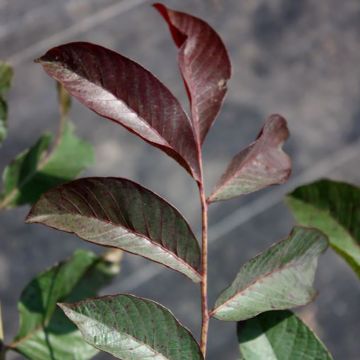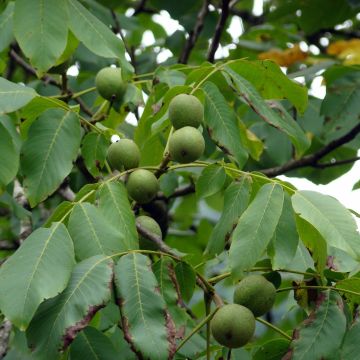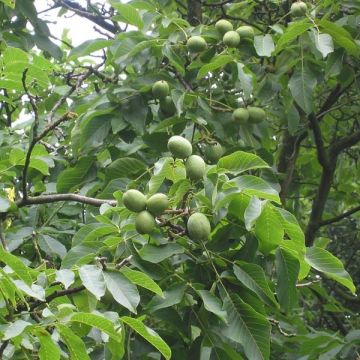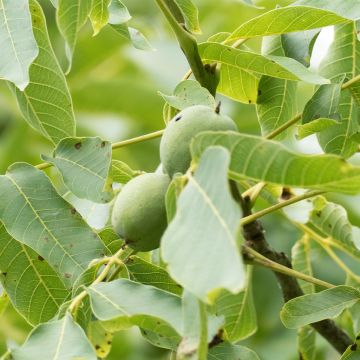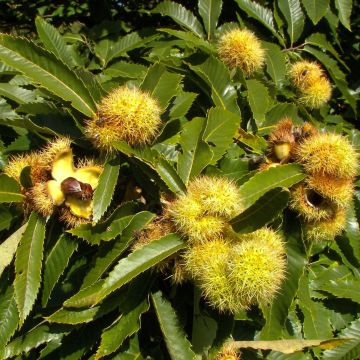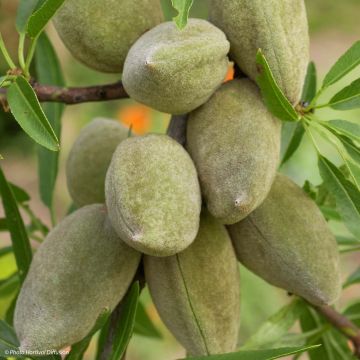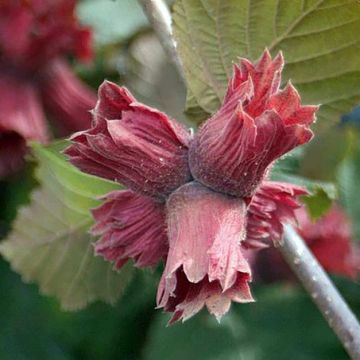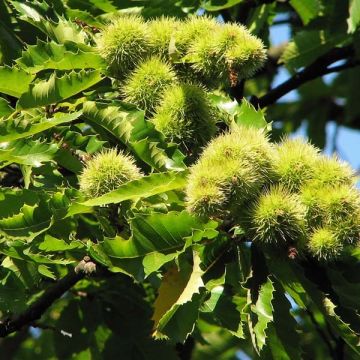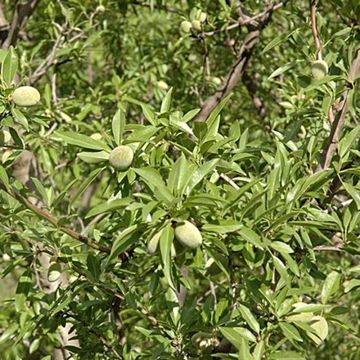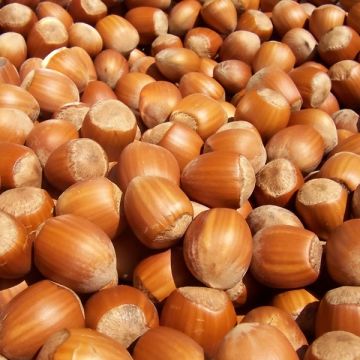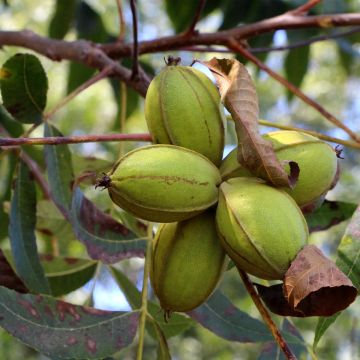Shipping country and language
Your country of residence may be:
Your country of residence is:
For a better user experience on our website, you can select:
Your shipping country:
Andorra
Austria
Belgium
Bulgaria
Canada
Chile
Croatia
Cyprus
Czechia
Denmark
Estonia
Finland
France
Germany
Greece
Hungary
Iceland
Ireland
Italy
Latvia
Lithuania
Luxembourg
Malta
Monaco
Netherlands
Poland
Portugal
Romania
Slovakia
Slovenia
Spain
Sweden
Switzerland
United Kingdom
We only deliver seed and bulb products to your country. If you add other products to your basket, they cannot be shipped.
Language:
French
German
Spanish
English
My Account
Hello
My wish lists
Plantfit
Log in / Register
Existing customer?
New customer?
Create an account to track your orders, access our customer service and, if you wish, make the most of our upcoming offers.


Common Walnut Franquette - Juglans regia
Common Walnut Franquette - Juglans regia
Juglans regia Franquette
Common Walnut, English Walnut, Persian Walnut
Rien à dire sur l'arbre, l'accueil téléphonique, tout est parfait. Mais le système de livraison n'est pas top : livraison décalée de plusieurs jours par rapport aux prévisions. A revoir, peut-être.
Patrick, 10/11/2021
Order in the next for dispatch today!
Dispatch by letter from 3,90 €.
Delivery charge from 5,90 € Oversize package delivery charge from 6,90 €.
More information
This item is not available in your country.
Shipping country:
Andorra
Austria
Belgium
Bulgaria
Canada
Chile
Croatia
Cyprus
Czechia
Denmark
Estonia
Finland
France
Germany
Greece
Hungary
Iceland
Ireland
Italy
Latvia
Lithuania
Luxembourg
Malta
Monaco
Netherlands
Poland
Portugal
Romania
Slovakia
Slovenia
Spain
Sweden
Switzerland
United Kingdom
Schedule delivery date,
and select date in basket
This plant carries a 6 months recovery warranty
More information
We guarantee the quality of our plants for a full growing cycle, and will replace at our expense any plant that fails to recover under normal climatic and planting conditions.
Oversize package: home delivery by special carrier from 6,90 € per order..
Express home delivery from 8,90 €.
Oversize package: home delivery by special carrier from 6,90 € per order..
Express home delivery from 8,90 €.
Description
The Juglans regia 'Franquette' is a variety of common walnut extensively cultivated in our territory, and it is one of the varieties of the Grenoble Walnut PDO. The walnut of this variety is of medium size, with an elongated hard shell and a well-filled and good-tasting kernel. This majestic tree requires space and will start producing from its fifth year. Franquette is a self-fertile variety, highly productive and late-ripening. It can be cultivated alone, but the yield will be better with other walnut trees nearby. It is very hardy, resistant to drought and diseases.
The Juglans regia or common walnut belongs to the Juglandaceae family and is native to China, Iran, and Southeast Europe. The Franquette variety is an old variety, obtained in the early 19th century by Nicoud-Franquet from Notre Dame de l'Osier in Isère. It is a majestic tree with a spreading habit that requires a large garden as it reaches 10 meters (33 feet) in height in 20 years and can grow up to 20 meters (66 feet) at maturity. Its spread is equally imposing and can reach up to 18 meters (59 feet). However, in orchards, there is a distance of 10 meters (33 feet) between two trees. No planting is possible below its canopy, as few plants can withstand its competition, due to the production of juglone, a toxic aromatic compound for most plants. The walnut of the 'Franquette' variety is ready to harvest in October. It is of medium size, elongated and pointed at the top, rounded at the base, with a hard shell and a large, good-tasting kernel, delicious both fresh and dried. This variety has a relatively late fruiting period. For quick fruiting, expect five years before your first harvest.
Walnut trees in general prefer fresh and deep, well-drained soils, as they dislike stagnant moisture as well as prolonged droughts. Severe winters can limit their fruiting and weaken the trees.
Common Walnut Franquette - Juglans regia in pictures


Plant habit
Fruit
Flowering
Foliage
Botanical data
Juglans
regia
Franquette
Juglandaceae
Common Walnut, English Walnut, Persian Walnut
Cultivar or hybrid
Other Walnut trees
Planting and care
Plant your Walnut Franquette in a well-sunny and isolated position in a deep soil. It tolerates limestone and clay, but prefers loose soils to extend its roots. Create a beautiful planting hole enriched with humus and a little gravel. During the first years, make sure to water your walnut tree during periods of drought. You can optionally add well-decomposed compost to its base in autumn. During the first 5 years, encourage the formation of 3 or 4 main branches, giving it a goblet shape, which is traditional in fruit tree cultivation. Harvesting takes place in October, and the fruit is just as good fresh as it is dried. To dry your walnuts, place them in a well-ventilated area, spread out to limit the risk of mould on the tree rings. You can also harvest green walnuts in June, on Saint John's Day, for making walnut wine.
Planting period
Intended location
Care
- , onOrder confirmed
Reply from on Promesse de fleurs
Shell fruit
Haven't found what you were looking for?
Hardiness is the lowest winter temperature a plant can endure without suffering serious damage or even dying. However, hardiness is affected by location (a sheltered area, such as a patio), protection (winter cover) and soil type (hardiness is improved by well-drained soil).

Photo Sharing Terms & Conditions
In order to encourage gardeners to interact and share their experiences, Promesse de fleurs offers various media enabling content to be uploaded onto its Site - in particular via the ‘Photo sharing’ module.
The User agrees to refrain from:
- Posting any content that is illegal, prejudicial, insulting, racist, inciteful to hatred, revisionist, contrary to public decency, that infringes on privacy or on the privacy rights of third parties, in particular the publicity rights of persons and goods, intellectual property rights, or the right to privacy.
- Submitting content on behalf of a third party;
- Impersonate the identity of a third party and/or publish any personal information about a third party;
In general, the User undertakes to refrain from any unethical behaviour.
All Content (in particular text, comments, files, images, photos, videos, creative works, etc.), which may be subject to property or intellectual property rights, image or other private rights, shall remain the property of the User, subject to the limited rights granted by the terms of the licence granted by Promesse de fleurs as stated below. Users are at liberty to publish or not to publish such Content on the Site, notably via the ‘Photo Sharing’ facility, and accept that this Content shall be made public and freely accessible, notably on the Internet.
Users further acknowledge, undertake to have ,and guarantee that they hold all necessary rights and permissions to publish such material on the Site, in particular with regard to the legislation in force pertaining to any privacy, property, intellectual property, image, or contractual rights, or rights of any other nature. By publishing such Content on the Site, Users acknowledge accepting full liability as publishers of the Content within the meaning of the law, and grant Promesse de fleurs, free of charge, an inclusive, worldwide licence for the said Content for the entire duration of its publication, including all reproduction, representation, up/downloading, displaying, performing, transmission, and storage rights.
Users also grant permission for their name to be linked to the Content and accept that this link may not always be made available.
By engaging in posting material, Users consent to their Content becoming automatically accessible on the Internet, in particular on other sites and/or blogs and/or web pages of the Promesse de fleurs site, including in particular social pages and the Promesse de fleurs catalogue.
Users may secure the removal of entrusted content free of charge by issuing a simple request via our contact form.
The flowering period indicated on our website applies to countries and regions located in USDA zone 8 (France, the United Kingdom, Ireland, the Netherlands, etc.)
It will vary according to where you live:
- In zones 9 to 10 (Italy, Spain, Greece, etc.), flowering will occur about 2 to 4 weeks earlier.
- In zones 6 to 7 (Germany, Poland, Slovenia, and lower mountainous regions), flowering will be delayed by 2 to 3 weeks.
- In zone 5 (Central Europe, Scandinavia), blooming will be delayed by 3 to 5 weeks.
In temperate climates, pruning of spring-flowering shrubs (forsythia, spireas, etc.) should be done just after flowering.
Pruning of summer-flowering shrubs (Indian Lilac, Perovskia, etc.) can be done in winter or spring.
In cold regions as well as with frost-sensitive plants, avoid pruning too early when severe frosts may still occur.
The planting period indicated on our website applies to countries and regions located in USDA zone 8 (France, United Kingdom, Ireland, Netherlands).
It will vary according to where you live:
- In Mediterranean zones (Marseille, Madrid, Milan, etc.), autumn and winter are the best planting periods.
- In continental zones (Strasbourg, Munich, Vienna, etc.), delay planting by 2 to 3 weeks in spring and bring it forward by 2 to 4 weeks in autumn.
- In mountainous regions (the Alps, Pyrenees, Carpathians, etc.), it is best to plant in late spring (May-June) or late summer (August-September).
The harvesting period indicated on our website applies to countries and regions in USDA zone 8 (France, England, Ireland, the Netherlands).
In colder areas (Scandinavia, Poland, Austria...) fruit and vegetable harvests are likely to be delayed by 3-4 weeks.
In warmer areas (Italy, Spain, Greece, etc.), harvesting will probably take place earlier, depending on weather conditions.
The sowing periods indicated on our website apply to countries and regions within USDA Zone 8 (France, UK, Ireland, Netherlands).
In colder areas (Scandinavia, Poland, Austria...), delay any outdoor sowing by 3-4 weeks, or sow under glass.
In warmer climes (Italy, Spain, Greece, etc.), bring outdoor sowing forward by a few weeks.

